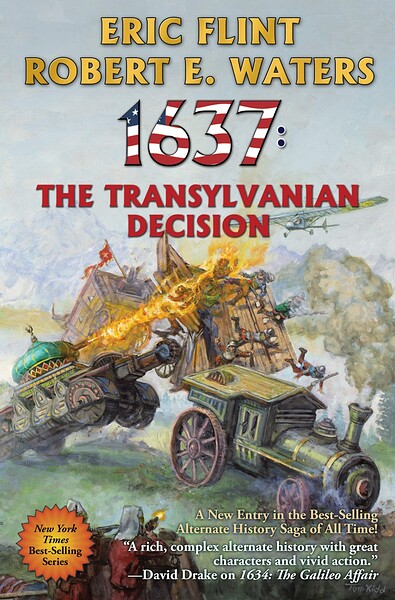Looking for a good read? Here is a recommendation. I have an unusual approach to reviewing books. I review books I feel merit a review. Each review is an opportunity to recommend a book. If I do not think a book is worth reading, I find another book to review. You do not have to agree with everything every author has written (I do not), but the fiction I review is entertaining (and often thought-provoking) and the non-fiction contain ideas worth reading.
Book Review
Ring of Fire In Transylvania
Reviewed by Mark Lardas
November 20, 2022
“1637: The Transylvanian Decision,” by Eric Flint and Robert E. Waters, Baen Books, 2022, 352 pages, $25.00 (Hardcover), $9.99 (Ebook)
In 2001 Eric Flint wrote a one-off novel titled “1632,” featuring a West Virginia town transposed in time and space to Thirty Years War Germany. It spawned numerous sequels, resulting in multiple series captured under the Ring of Fire umbrella. It even gave birth to a new publishing house focused on these stories.
“1637: The Transylvanian Decision,” by Eric Flint and Robert E. Waters, is the latest book in the series. It is also the last book written by Flint. He died in July 2022.
Over six years since the Ring of Fire, up-timer Morris Roth, transformed himself from Grantville jeweler too the commander of the Grand Army of the Sunrise, stationed in Bohemia. Roth, who is Jewish, created the army to prevent the 1648 Chmielnicki Pogrom. He is trying to carve out a Jewish homeland in territories east of Bohemia, in what in the future became Russia’s Pale of Settlement.
He is offered an alliance with Transylvania, then an Ottoman client state. Transylvania wants independence and is willing to aid Roth’s move into Ruthenia in exchange for military assistance against the Ottomans. After the United States of Europe offers to assist Roth and his army, Roth agrees to the alliance. A Transylvanian campaign will aid the USE, fighting the Ottomans in Austria.
The Army of the Sunrise is made up of Jewish infantry, the Bohemian Brethren (a Protestant sect evolved from the Hussites) and mercenary cavalry. The Brethren have armored wagons and locomotives. For the campaign it is being reinforced by a brigade of the Silesian Guard, commanded by Jeff Higgins and Sons of Liberty political organizers led by Gretchen Higgins, Jeff’s formidable spouse.
Against that the Ottoman Caliph is using vassals from Wallachia and Moldavia to put down the Transylvanian uprising, reinforcing them with Ottoman-built tanks (steam-powered and armed with flamethrowers), an Ottoman zeppelin, and Janissaries. The results will be bloody.
This book follows one of several side threads that branched off from the main story, which Flint tended to write solo. However, this thread was one close to Flint’s heart, one he created in the first Ring of Fire short story collection. Despite a co-author, it reads in many ways like one of his main line novels.
“1637: The Transylvanian Decision” offers what readers of the series expect; action mixed with technology, and the appearance of many familiar characters. It is a worthy addition to the series.
Mark Lardas, an engineer, freelance writer, historian, and model-maker, lives in League City. His website is marklardas.com.
